The ASUS X99 Rampage V Extreme ROG Review
by Ian Cutress on June 22, 2015 8:45 AM EST- Posted in
- Motherboards
- Asus
- ROG
- Haswell-E
- X99
System Performance
Power Consumption
Power consumption was tested on the system while in a single MSI GTX 770 Lightning GPU configuration with a wall meter connected to the OCZ 1250W power supply. This power supply is Gold rated, and as I am in the UK on a 230-240 V supply, leads to ~75% efficiency > 50W, and 90%+ efficiency at 250W, suitable for both idle and multi-GPU loading. This method of power reading allows us to compare the power management of the UEFI and the board to supply components with power under load, and includes typical PSU losses due to efficiency. These are the real world values that consumers may expect from a typical system (minus the monitor) using this motherboard.
While this method for power measurement may not be ideal, and you feel these numbers are not representative due to the high wattage power supply being used (we use the same PSU to remain consistent over a series of reviews, and the fact that some boards on our test bed get tested with three or four high powered GPUs), the important point to take away is the relationship between the numbers. These boards are all under the same conditions, and thus the differences between them should be easy to spot.
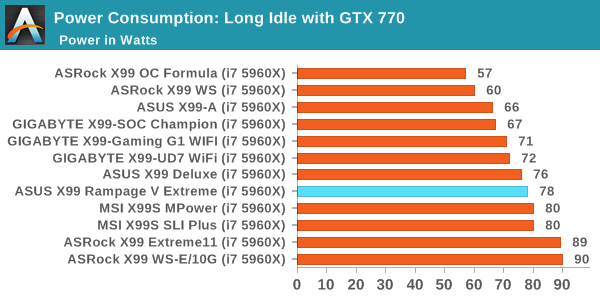

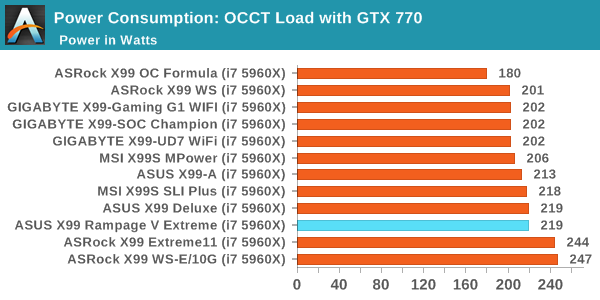
Power Consumption for X99 seems to hover around three points in our test – 200W, 220W and 240W. This puts the Rampage V Extreme in the middle, with similarly placed idle and long idle results.
Windows 7 POST Time
Different motherboards have different POST sequences before an operating system is initialized. A lot of this is dependent on the board itself, and POST boot time is determined by the controllers on board (and the sequence of how those extras are organized). As part of our testing, we look at the POST Boot Time using a stopwatch. This is the time from pressing the ON button on the computer to when Windows 7 starts loading. (We discount Windows loading as it is highly variable given Windows specific features.)
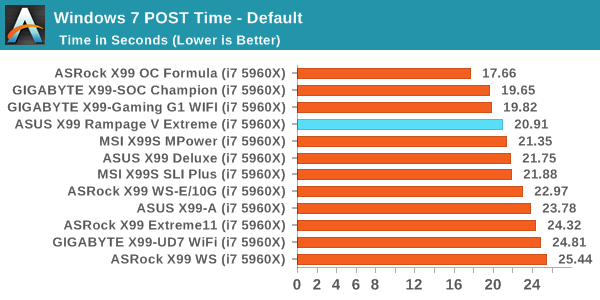
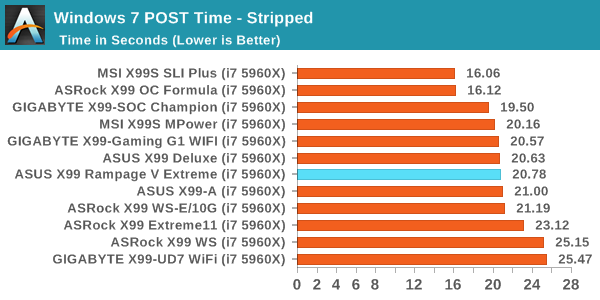
Typically the more hardware features we have, the longer the time to post. In this circumstance the Extreme does well, and the holy grail of 20 seconds for X99 is not too far away. One of the big issues with X99, as we mentioned earlier in the review, is that DRAM training can take up to 50% of this time but is a necessary part in order to ensure stability.
Rightmark Audio Analyzer 6.2.5
Rightmark:AA indicates how well the sound system is built and isolated from electrical interference (either internally or externally). For this test we connect the Line Out to the Line In using a short six inch 3.5mm to 3.5mm high-quality jack, turn the OS speaker volume to 100%, and run the Rightmark default test suite at 192 kHz, 24-bit. The OS is tuned to 192 kHz/24-bit input and output, and the Line-In volume is adjusted until we have the best RMAA value in the mini-pretest. We look specifically at the Dynamic Range of the audio codec used on board, as well as the Total Harmonic Distortion + Noise.
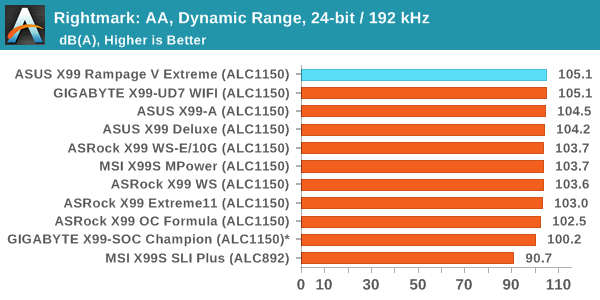
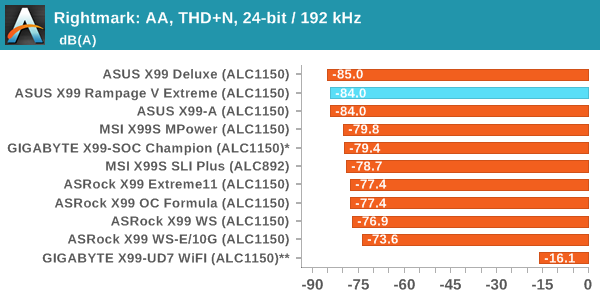
Similar to the X99 Deluxe, the Extreme performs very well here.
USB Backup
For this benchmark, we transfer a set size of files from the SSD to the USB drive using DiskBench, which monitors the time taken to transfer. The files transferred are a 1.52 GB set of 2867 files across 320 folders – 95% of these files are small typical website files, and the rest (90% of the size) are small 30 second HD videos. In an update to pre-Z87 testing, we also run MaxCPU to load up one of the threads during the test which improves general performance up to 15% by causing all the internal pathways to run at full speed.
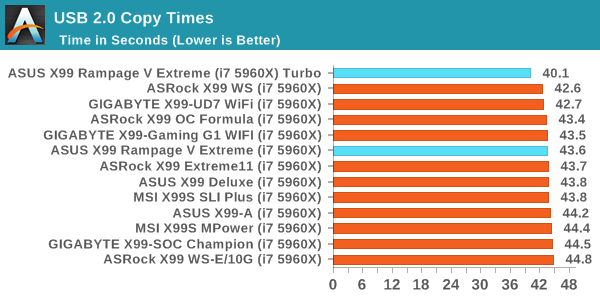
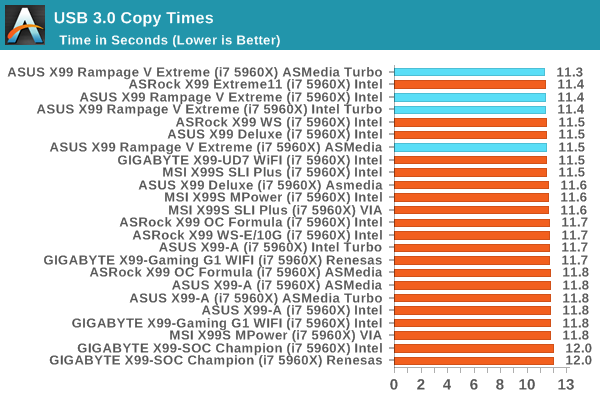
All of our USB 3.0 results have hovered between 11.4 and 12.0 with a couple of outliers, so it is good to see an 11.4 second result.
DPC Latency
Deferred Procedure Call latency is a way in which Windows handles interrupt servicing. In order to wait for a processor to acknowledge the request, the system will queue all interrupt requests by priority. Critical interrupts will be handled as soon as possible, whereas lesser priority requests such as audio will be further down the line. If the audio device requires data, it will have to wait until the request is processed before the buffer is filled.
If the device drivers of higher priority components in a system are poorly implemented, this can cause delays in request scheduling and process time. This can lead to an empty audio buffer and characteristic audible pauses, pops and clicks. The DPC latency checker measures how much time is taken processing DPCs from driver invocation. The lower the value will result in better audio transfer at smaller buffer sizes. Results are measured in microseconds.

Under 100 microseconds. Tick.










41 Comments
View All Comments
frodbonzi - Monday, June 22, 2015 - link
This board is many months old... why is the review coming out now?!!?!?Saying that, it's a great board... If you are trying to use the M.2 SAS connector I should warn you that the cable will force your video card up in the first slot... Had a buddy blow his board that way (ASUS sent a replacement and acknowledged that it's a known problem!).
If you are trying to use a PCIE HD (I have the Intel 750), triple SLI AND use the USB 3.1 add-on card... let me know, as I'm still unable to get it to go (I thought I could get the SSD into the black PCIE_X4 slot, but there doesn't seem to be enough room with all the red PCIE_x16 slots occupied (3 TitanX and the USB 3.1 card)...
mazzy80 - Tuesday, June 23, 2015 - link
Why add a M.2 slot on a EATX board, with limit capacity, even more on a Extreme board ?The space is not a problem on a Big Tower, a PCI-e slot SSD is not limited on the PCIe lanes or capacity.
maybe a day it'll possible to buy a full slot x16 PCIe 3.0 SSD for extreme performance...
SATA Express is a waste of space, useless..
why a integrated Audio card ? If I can pay $500 for a motherboard I can pay $100 for a top of line Audio card of my choice.
I don't see how X99 can match the X79 success. A underwhelming High-End platform that will look old in 2 month when Skylake will be out... 2 gen ahead... with the new DMI 3.0, new SAS ports, cheaper and faster.
frodbonzi - Monday, June 22, 2015 - link
Another thing... when reviewing such a high-end motherboard, why are all of the benchmarks (except for the last Shadow of Mordor one) in 720p or 1080p?If you're buying a $1000+ processor and $400+ motherboard, you are most likely gaming at at LEAST 1440p, if not 4k...
ggathagan - Monday, June 22, 2015 - link
Generally, sites will test motherboards and CPU's at lower resolutions to eliminate the GPU from the equation as much as possible.pseudoid - Tuesday, June 23, 2015 - link
Thanx for the review!Back in the day of Intel X38 Core2 Extreme, I had the Asus Maximus Formula SE MoBo, based on AnandTech's review! It would not die! But now that Asus has decided the ROG boards are not worthy of dual NICs, I won't go near them, as I got spoiled running a NAS off the 2nd LAN. It is also funny that Asus has never seen fit to integrate a cheezy $2 speaker on their MoBoz, when boot errors are detected/occur!
AnandKid - Friday, June 26, 2015 - link
I like the RAMdisk solution - they should work on that in next generation of MOBOs. For instance add a Li-ion battery to keep RAM disk refreshed for some time - that would enable using it as 'normal' disk drive and boot the system option should be then added. I still remember in 2006 Gigabyte i-RAM card - amazing thing! (http://techreport.com/review/9312/gigabyte-i-ram-s... should make another one for PCIe 3.0. no need to wait for PCIe 4.0 - come on ASUS bring it on!skypine27 - Friday, June 26, 2015 - link
Im a high end, and target audience, user of this board. System specs:*CPU: Intel 5960x @ 4.2 ghz on Corsair H110i GT WaterCool Unit
*Mobo: Asus Rampage V Extreme
*RAM: 32 GB DDR4 G.Skill Ripjaws4 3000 (set to 2400)
*Graphics: 2 x Titan X (Nvidia Reference cards) SLI
*Monitor: LG 34UC97 curved 34" 3440 x 1440 @ 60hz
*Storage A: Samsung SM951 512MB Windows 8.1
*Storage B/C/D: 2 x V-Raptor 1.0TB Raid0. 1 x Crucial M4 512MB. 12TB USB 3.0 External Raid0
*Case/PSU: Thermaltake V51+ Corsair AX1200i PSU + Windows 8.1 Pro 64-bit
People that are complaining "E-ATX kills it for me...". Well, go back and google the Extreme lineup from Asus. They have been E-ATX for a LONG time. These aren't, and never were, aimed at guys going for a tiny build.
I like the M2 slot. The SM 951 Im running as a boot drive (+ Star Citizen) gets performance that clobbers even a 2 x SSD Raid 0 setup. And, it tucks out of the way and is totally concealed beneath my #1 Titan X.
Anyway, if size is a concerning, don't waste your time ever looking at an Asus Extreme product. They will always be "max size"
Oscarcharliezulu - Friday, June 26, 2015 - link
The grammar in this article is giving me headache. It reads like a clean up of a google translation.Oscarcharliezulu - Friday, June 26, 2015 - link
One benefit I found from my old gene mtx board other than it worked so damned well was the fantastic resale on eBay - I bought it second hand and sold it 2 years later and got a lot of my money back. ROG are top of the line so people seek them out rather than cheaper boards. And this was a 775 chipset which was 2 generations old when I sold it.godzrule - Monday, July 20, 2015 - link
Can I have a 5820k i7 running 2x980ti in 16x and 8x(or16x?) and then have my 951 M.2 running at its full speed on 4x as my Boot drive? The 5820k has 28 pcie lanes and so 16+8+4=28 But i would like everyones thoughts on this as its been impossible to find solid info thanks!